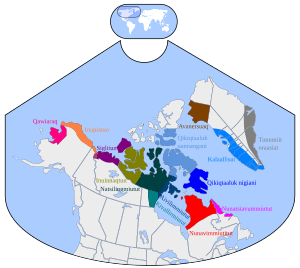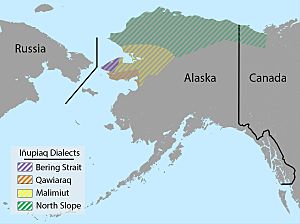Inupiat language facts for kids
The Inupiaq language is a group of dialects spoken by the Inuit people. It is also known as Alaskan Inuit. The word "Inupiaq" can also refer to the people who speak this language.
Most Inupiaq speakers live in northern and northwestern Alaska. Some also live in parts of the Northwest Territories in Canada. You can also find speakers on Little Diomede Island. Big Diomede Island, which belongs to Russia, used to have speakers but is now empty.
The Inupiaq language is very similar to other Inuit languages. These include languages spoken in Canada and Greenland.
Today, about 2,000 people speak Inupiaq in Alaska. Around 24,000 people speak it in Canada. Sadly, it is considered a threatened language. Most people who speak it are 40 years old or older. Inupiaq is an official language in the State of Alaska.
You might see the name spelled in different ways. Some common spellings are Inupiatun, Iñupiatun, Iñupiaq, and Inupik.
Main Dialects of Inupiaq
The Inupiaq language has two main groups of dialects. These are Northern Alaskan Iñupiaq and Seward Peninsula Iñupiaq.
How Dialects Are Different
There are differences in sounds and words among the dialects. Speakers of two of the three main dialects can usually understand each other. This is true even if they use different words or forms.
For example, in the North Slope dialect, tupiq means "tent." But in the Malimiut dialect, tupiq means "house." The North Slope dialect uses iglu for "house."
Sometimes, the difference is mostly in how a word is spelled. The word for "dog" is qimmiq in North Slope. It is qipmiq in Malimiut.
The dialect spoken on the Seward Peninsula is quite different. People who speak it might need some practice to understand the other two dialects.
History of the Language
The Inupiaq language has been used less and less since the late 1800s. This was when English speakers first came to Alaska.
After Alaska became part of the United States, many new people moved there. Often, Inuit children were sent to boarding schools far from home. At these schools, they learned English. However, they often lost their Inupiaq language skills. They also lost touch with their Inuit culture.
Because of this, only a small number of Inupiat people speak the Inupiaq language today. But many communities are now working hard to bring the language back. They want to make sure it is spoken by future generations.
See also
- In Spanish: Idioma iñupiaq para niños



